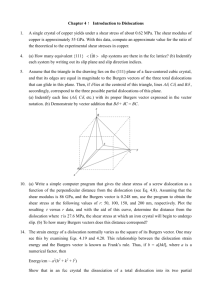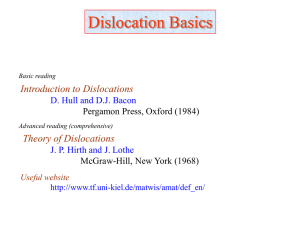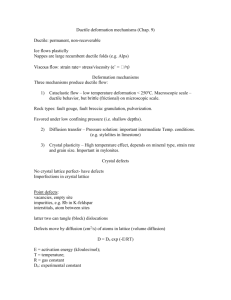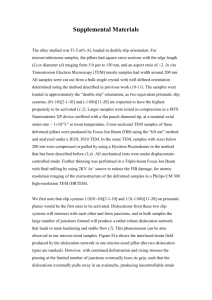dislocations
advertisement
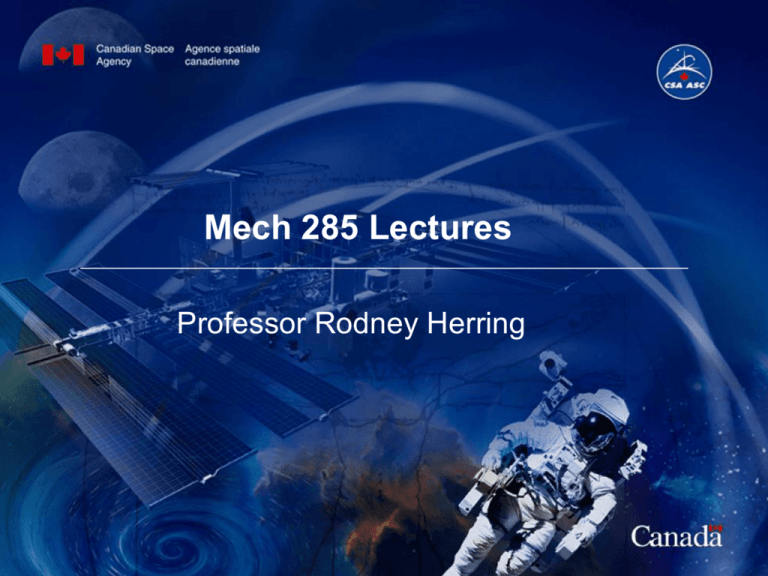
Mech 285 Lectures
Professor Rodney Herring
Dislocations
• Dislocations are very important imperfections in real materials.
• Dislocations are line imperfections in otherwise perfect lattices.
• Dislocations are formed during solidification or when the
material is deformed.
• Dislocations strongly affect the mechanical, electronic and
photonic properties of materials.
• There are two basic types of dislocations – edge and screw.
The perfect crystal in a) is cut and sheared one atom spacing in b)
and c). The line along which the shearing occurs is a screw
dislocation. A Burgers vector b is required to close a loop of equal
atom spacings around the screw dislocation.
a)
b)
c)
The perfect crystal in a) is cut and an extra plane of atoms is inserted
in b). The bottom edge of the extra plane is an edge dislocation in c).
A Burgers vector b is required to close a loop of equal atom spacings
around the edge dislocation.
A mixed dislocation showing a screw dislocation at the front of the
crystal gradually changing to an edge dislocation at the side of the
crystal. Note that the line direction of the dislocation is parallel to
the Burgers vector of the screw dislocation and perpendicular to the
edge dislocation.
When a shear stress is applied to the dislocation in a)
the atoms are displaced, causing the dislocation to move
one Burgers vector in the slip direction b). Continued
movement of the dislocation creates a step c) and the
crystal is deformed. Motion of a caterpillar (or a fold in
a rug) is analogous to the motion of a dislocation.
Note: the slip direction is always in the direction of the
Burgers vector of the dislocation.
Stress at Dislocation Cores
Stress contours around edge and screw dislocations. Edge
dislocations are much more complex than screw dislocations.
Stress field around edge dislocation.
Stress field around screw dislocation.
Dislocations in Ti3Al seen by TEM
showing dislocation pileups in a) and
b) and how they contribution to
permanent or plastic deformation in c).
Control of Dislocations
• Control of dislocations allow us to manipulate mechanical
properties and understand their temperature dependence.
• When a shear force acting in the direction of the Burger’s vector
is applied to a crystal containing a dislocation, the dislocation
can move by breaking bonds between the atoms in one plane.
• By this process, the dislocation moves through the crystal to
produce a step on the exterior of the crystal.
• The process by which the dislocation moves and causes a solid
to deform is called slip.
Dislocation Slip
• Dislocations move more readily in some crystal planes and
directions than in others as we will see.
• The slip direction of an edge dislocation is in the direction of the
Burger’s vector.
• A slip plane is defined by the direction of the Burger’s vector
and the line direction of the dislocation
– The line direction of a screw dislocation is in the same
direction as its Burger’s vector.
– An edge dislocation has its Burger’s vector perpendicular to
the line direction of a dislocation
– A dislocation having a line direction not parallel or
perpendicular to the Burger’s vector is considered a mixed
dislocation.
Dislocation Slip
• During slip the dislocation moves from one set of surroundings
to another identical set.
• The least amount of energy expenditure requires movement in
directions in which the repeat distance is shortest, i.e., closepacked directions.
• Slip planes tend to be those planes with a high planar packing,
i.e., close-packed planes.
• Slip reduces strength but increase ductility in materials.
,u
,b
b
b
,R
Schematic of slip line, slip plane and slip vector (Burgers vector) for
a) an edge dislocation and b) a screw dislocation. Note the
relationships between the dislocation line (u), slip vector (b) and glide
plane (R) where R = b x u.
u
An edge dislocation
in MgO.
Dislocations in
ceramics and
semiconductors are
complicated by
charges existing at
their core requiring
large energies for
them to glide.
Fracture does not
occur in these
materials by
dislocation glide
but by cracks
(surface defects).
If these dislocations can’t glide, why do they
exist and how do they move?
Defects in GaAs/InGaAs Laser
Note that the laser looks to have a perfect crystal structure when using the
200[011] electron diffraction vector but actually has dislocations, which moved
into the active region by creep, when viewed using the 220[110].
Dark lines are InGaAs layers and
light lines are GaAs layers
plus substrate and capping
layers.
Dislocation Core Structure in GaAs
Definition of alpha (Ga-core) and beta (As-core) dislocations:
removal of the segment 1564 leads to the formation of an Asterminated dislocation and 1234 leads to the formation of a Gaterminated dislocation.
A Ga core will have excess holes whereas an As core will have excess
electrons.
Dislocation-Dislocation Interactions
GaAs has ZnS
structure which
can be treated as
a FCC structure
where the close
packed planes
are the {111} and
the close packed
directions are the
<110>.
Schematic of two dislocations interacting to form one dislocation.
Surface Defects
• Surface defects are another type of imperfection in real materials.
• They consist of the boundaries or planes that separate a material
into regions of different crystal structure or orientation.
– The material’s surface is one example
– Grain boundaries are another example of a surface defect.
– Others are stacking faults, twin boundaries and magnetic
domain boundaries
• As we saw in the electron images of the atoms (lattice images),
grain boundaries are narrow zones where the atoms are not
properly spaced in which tension or compression exists.
• Grain size influences many material properties such as strength
and electrical conductivity.
Grain boundaries showing in a) that the atoms at the boundaries
near the three grains (referred to as a triple point) do not have an
equilibrium spacing and in b) grains in a stainless steel sample.
The angle, q, of a tilt boundary is
made from three dislocations and
can be described by the equation
below.
b
sin q b / 2D
2D
q/2
Note – Grain boundaries are a
two-dimensional array of
dislocations.
Low angle grain
boundaries in
Cubic Zirconia
seen using by
TEM
Dickey et. al., Microscopy
and Microanalysis (2000) pg.
120
Planar Defect – Stacking Fault
A stacking fault is shown where atomic column “a” is
interfaced with atomic column “b”, which resulted from the
dislocations found on either end of the stacking fault.
Lattice Image
of a "Stacking
fault" in
GaAs showing
reverse
ordering of
Ga and As
planes. Note
the partial
dislocation at
the start of
the fault.
Kisielowski et. al.
Microscopy and
Microanalysis (2000) pg.
16
A twin boundary, which is a planar defect, is shown where a
displacement of atoms by a stress reorients a volume of the
crystal, which is bounded by the twin boundary.
The material Brass, a copper zinc alloy, deforms by the
formation of twins. The twin boundaries are at the
interface of the dark and line regions.
Formation of Twins
original twin
width
Gradual reduction
of twin width due
to emission of
dislocations from
grain boundary
Dislocation mechanism for twin boundary migration
(reduction in width) using dislocations.
Twin boundaries and dislocations recently found in small
LaF3 crystals. LaF3 is a light emitting diode material.
The End
(Any questions or comments?)

